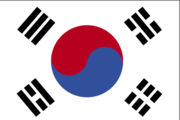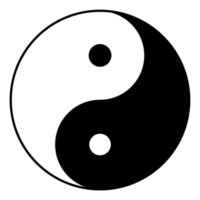Yin and yang
|
|
Yingyang-dragon-tiger.jpg
The concept of yin and yang (Template:Zh-tsp) originates in ancient Chinese philosophy and metaphysics, which describes two primal opposing but complementary forces found in all things in the universe. Yin, the darker element, is passive, dark, feminine, downward-seeking, and corresponds to the night; yang, the brighter element, is active, light, masculine, upward-seeking and corresponds to the day.
The pair probably goes back to ancient agrarian religion; it exists in confucianism, and it is prominent in taoism, though the words yin and yang only appear once in the Tao Te Ching.
Yin and yang are complementary opposites rather than absolutes. Most forces in nature can be broken down into its respective yin and yang states, and the two are usually in movement rather than held in absolute stasis.
| Contents |
Meaning of terms
The meaning of the characters for yin and yang, necessarily, has more than just one connotation. Because yang means "sunny", it corresponds to the day and more active functions. Whereas yin, meaning "shady", corresponds to night and less active functions. Yin and yang can be compared in the chart to the right.
It is also possible to look at yin and yang with respect to the flow of time. Noon, is full yang, sunset is yang turning to yin; midnight is full yin and sunrise is yin turning to yang. This flow of time can also be expressed in seasonal changes and directions. South and summer are full yang; west and autumn are yang turning to yin; north and winter are full yin, and east and spring are yin turning into yang.
Yin and yang can also be seen as a process of transformation which describes the changes between the phases of a cycle. For example, cold water (yin) can be boiled and eventually turn into steam (yang).
One way to write the symbols for yin and yang are a solid line (yang) and a broken line (yin) which could be divided into the four stages of yin and yang and further divided into the eight trigrams (these trigrams are used on the South Korean flag). The symbol shown at the top righthand corner of this page, called Taijitu (太極圖), is another way to show yin and yang. The mostly white portion, being brighter, is yang and the mostly dark portion, being dim, is yin. Each, however, contains the seed of its opposite. Yin and yang are equally important, unlike the typical dualism of good and evil.
The concept is called yin yang, not yang yin, just because the former has a preferred pronunciation in Chinese (see Standard Mandarin - Tones for detail), and the word order has no cultural or philosophical meaning.
Principles
Everything can be described as either yin or yang
1. Yin and yang are opposites.
Everything has its opposite—although this is never absolute, only comparative. No one thing is completely yin or completely yang. Each contains the seed of its opposite. For example, cold can turn into hot; "what goes up must come down".
2. Yin and yang are interdependent.
One cannot exist without the other. For example, day cannot exist without night.
3. Yin and yang can be further subdivided into yin and yang.
Any yin or yang aspect can be further subdivided into yin and yang. For example, temperature can be seen as either hot or cold. However, hot can be further divided into warm or burning; cold into cool or icy.
4. Yin and yang consume and support each other.
Yin and yang are usually held in balance—as one increases, the other decreases. However, imbalances can occur. There are four possible imbalances: Excess yin, excess yang, yin deficiency, yang deficiency.
5. Yin and yang can transform into one another.
At a particular stage, yin can transform into yang and vice versa. For example, night changes into day; warmth cools; life changes to death.
6. Part of yin is in yang and part of yang is in yin.
The dots in each serve as a reminder that there are always traces of one in the other. For example, there is always light within the dark (e.g., the stars at night), these qualities are never completely one or the other.
Examples

Flag_of_Mongolia.png
Yin and yang can also be used (in conjunction with other characters) to indicate various parts of the male and female anatomy.
A modern example:
- Yin: the traffic light on the road (the stillness)
- Yang: the traffic that flows past that traffic light (activity)
Some Chinese, Korean and Japanese placenames that still exist are named in the following principle:
- Yin: the shady north side of the mountain, the south side of the river..
- Yang: the sunny south side of the mountain, the north side of the river.
While yin dominates femininity and yang masculinity, according to Traditional Chinese Medicine, within the body of either sex, each of the five elements has a pair of organs asigned to it one yin one yang. The yin organs meridian has a downward flow of energy and the yang upward. As a result, an imbalance of the yin-yang ratio can cause illness. This is not to say that everyone should have exactly half of each; every individual needs to find this balance depending on their own constitution, climate, season, occupation and even emotional environment. If in perfect health, the individual should be able to adapt to any of the inevitable changes of life.
Together, the symbolic colours of yin and yang, black (symbolising darkness, the absence of light) and white (symbolising light) respectively, are combined into a circle that symbolizes Taoism for many: the tàijíbāguàtú (太極八卦圖) (simplified Chinese 太级八卦图), often known as the T'ai Chi symbol or the Pictogram of the Supreme Ultimate. This graphical representation is however of a far more recent date than the word pair itself. Its Unicode code is U+262F (☯).
Taoist philosophy uses metaphor to describe the dynamic complexities of the human body's organic processes in traditional Chinese medicine as well as the complexities of human personality in (Chinese astrology). Nothing in the universe is completely yin or completely yang - everything is a mixture of the two. The yin yang symbol contains two smaller circles: a small circle of yin inside the yang, and a small circle inside the yin. Often misunderstood, these important circles reinforce the circular nature of the philosophy by symbolizing another Taoist tenet: one extreme will always change into its opposite, so that extreme yang turns into yin and vice versa. This is also symbolized in the yin-yang symbol by the shape of the outer swooshes, which appear to be moving, one into the other. This principle has been extended into the physical realm of full and empty, hard and soft, active and receptive, etc.
Over the centuries, the study of the interplay between these principles has also led to the formulation and refinement of several systems of martial arts across East Asia.
References
1. Nei Jing (Yellow Emperor's Classic of Medicine)
2. Ted J. Kaptchuk, OMD. "The Web that has No Weaver" McGraw-Hill 2000 ISBN 0-8092-2840-8
3. Maciocia, Giovanni "The Foundations of Chinese Medicine" Churchill-Livingstone 1989 ISBN 0-443-03980-1
See also
- Chinese philosophy
- Tao Te Ching
- dialectical monism
- five elements
- flag of South Korea
- I Ching
- neo-Confucianism
- Nei chia
- qi
- qigong
- T'ai Chi Ch'uan
- Taoism
- traditional Chinese medicine
- trinity
- universal dialectic
- Wushu
External links
- Yin-yang symbol defined and illustrated (http://www.chinesefortunecalendar.com/yinyang.htm)de:Yin und Yang
et:Yin ja yang fr:Yin-Yang it:Yin e Yang he:יין-יאנג ja:陰陽思想 nl:Yin Yang pl:Yin i yang pt:Yin yang vi:Âm dương zh:阴阳

